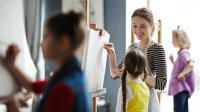The Impact of a Visiting Artist Program
It can benefit students well beyond arts classes, function as an in-place field trip, and strengthen your school’s ties to parents and the community.
Your content has been saved!
Go to My Saved Content.Why start a visiting artist program at your school? It can invigorate the curriculum and help address cuts to arts programs that have happened at many schools. It can also educate the school community about the value of art in our society.
Alternative to Field Trips
Another major benefit? Visiting artist programs can serve as a practical alternative to field trips. There are a good number of schools that are located outside of big cities and places with a high concentration of artists, galleries, and museums, so bringing artists to campus tackles many of the logistical challenges of taking students off campus.
More importantly, having a visiting artist can actually have a more in-depth impact on your classes than taking them to a museum or gallery. Artists coming to your classroom and school get to present their work and take questions from students. And they can engage with a wider number and spectrum of students, teachers, classes, and settings.
Visiting artists can provide feedback on student work and contribute to developing lessons. They can be a voice of counsel to parents and administrators, answering questions they might have about art as a career, or setting up a school-wide project such as the design of campus murals.
Not Just for Art Students
If you want to start a program at your school, one of the first things to make clear is that a visiting artist program can be beneficial for classes not only in the arts (e.g., photography, dance, drawing, and painting) but also in the humanities, the sciences, and math.
In fact, sometimes a visiting artist can have their biggest impact on students outside of classes in the arts. At one school, a landscape photographer who examined the impact that waste and pollution had on the environment was invited to a science class. The photographer introduced the ideas of visual investigation, observation, and documentation as way to help students think about and address ecological concerns. She also presented the impact that photography has had on the establishment of our national parks and raising awareness in general.
There are artists who, in their work, specifically address social issues in enlightening ways. One such artist, Dr. Frederick Gooding Jr., uses a performative character called “The Race Doctor” to address issues of racial stereotypes in film and TV. In his work on school campuses, his humorous character offers students a way to address thorny issues they might otherwise not feel comfortable discussing.
Visiting artists can broaden our understanding of what education might be for the entire community by challenging the “the correct answer” framework that can sometimes limit teaching and learning. The artist Oliver Herring worked with students at Maple Mountain High School in Utah, emphasizing using contemporary art to place students in an environment where process and experimentation were more important than the product and having the “right” answer.
Additionally, all students can benefit from hearing about the professional practice of working artists. Let’s not forget the influence and impact photographers, illustrators, and creative thinkers have on various fields, from science to journalism. Bringing a visiting artist to your school can help both students and parents know what those opportunities might be and give them a chance to hear from professionals in various arts and entertainment fields.
Getting Started
In setting up a visiting artist program at your school, consider these suggestions and ideas:
- Present your idea as program that has a beneficial impact on the entire community. That includes parents, students, and faculty.
- Design the programming so formal presentations are made in a variety of classes, at in-school assemblies and gatherings, and at evening events for parents and the larger community.
- Use the program to address specific topics and subjects that include both academic and non-academic subjects. These could include issues relating to politics, the economy, or local, national, and international news.
- Create opportunities for interdisciplinary projects between various classes. The arts often serve as the ideal bridge for breaking down silos and forming collaborations.
- Use the program to liven up faculty meetings.
- Reach out to alumni, parents, and faculty who might have experience in or connections to the arts. This will help deepen your knowledge of your community and make art that much more relevant to the students.
- Let the program serve as a bridge to the local community. Very often there is a gap between a school and the neighborhood where it’s located. A visiting artist program might offer evening programs or weekend events that draw in people who might not have a direct connection to the school. This can only benefit your school and strengthen its connections to the local community.
